This article needs additional citations for verification .(November 2014) |
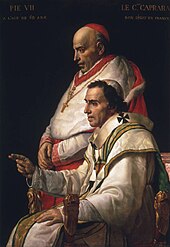
The relationship between Napoleon and the Catholic Church was an important aspect of his rule.
This article needs additional citations for verification .(November 2014) |

The relationship between Napoleon and the Catholic Church was an important aspect of his rule.

In 1796, French troops under the command of General Napoleon Bonaparte invaded Italy, defeated the Papal Army, and occupied Ancona and Loreto.
Pope Pius VI sued for peace, which was granted at Tolentino on 19 February 1797, but on 28 December that year, in a riot papal forces blamed on Italian and French revolutionaries, the popular Brigadier-General Mathurin-Léonard Duphot, who had gone to Rome with Joseph Bonaparte as part of the French embassy, was killed and a new pretext was furnished for invasion. General Louis-Alexandre Berthier marched to Rome, entered it unopposed on 10 February 1798 and, proclaiming a Roman Republic, demanded the pope renounce his temporal power.
Upon his refusal he was taken prisoner, and on 20 February he was escorted from the Vatican to Siena, and then to the Certosa near Florence. The French declaration of war against Tuscany led to his removal, escorted by the Spaniard Pedro Gómez Labrador, Marquis of Labrador, by way of Parma, Piacenza, Turin, and Grenoble to the citadel of Valence, the chief town of Drôme. He died there six weeks after his arrival, on 29 August 1799, having reigned longer than any pope.
Pius VI's body was embalmed, but was not buried until 30 January 1800 after Napoleon saw political advantage to burying his remains in an effort to bring the Catholic Church back into France.
Napoleon realised the importance of religion as a means to increase obedience and his power and control over the French. It was not until the conclave of cardinals had gathered to elect a new pope that Napoleon decided to bury Pius VI who had died several weeks earlier. He gave him a gaudy ceremony in an effort to gain the attention of the Catholic Church. This eventually led to the Concordat of 1801 negotiated by Ercole Consalvi, the pope's secretary of state, which re-systemised the linkage[ clarification needed ] between the French church and Rome. However, the Concordat also contained the "Organic Articles" which Consalvi had fiercely opposed but which Napoleon had nevertheless instituted.
The papacy had suffered a major loss of church lands through secularisations in the Holy Roman Empire following the Treaty of Lunéville in 1801, when a number of German princes were compensated for their losses by the seizure of ecclesiastical property.
The Concordat of 1801 was an agreement between Napoleon Bonaparte and Pope Pius VII that reaffirmed the Roman Catholic Church as the majority church of France and restored some of its civil status.
While the Concordat restored some ties to the papacy, it largely favoured the interests of the French state; the balance of church-state relations had tilted firmly in Bonaparte's favour. As a part of the Concordat, he presented another set of laws called the Organic Articles.
From the beginning of his papacy to the fall of Napoleon in 1815, Pius VII was completely involved with France.[ clarification needed ] He and Napoleon were continually in conflict, often involving the French leader's wishes for concessions to his demands.

Despite the opposition of most of the Roman Curia, Pius VII traveled to Paris for Napoleon's coronation in 1804. Napoleon placed the crown on his head himself, spurning the pope's intent to do so. The painting by Jacques-Louise David titled The Coronation of Napoleon depicts the seated pope at the ceremony as Napoleon crowns his wife.
Although the pope and the papacy were promised rich gifts and donations, Pius initially refused most of these offers. Napoleon did give him the Napoleon Tiara, decorated with large emeralds from the looted tiara of Pope Pius VI, but it was deliberately made too small and heavy to be worn and meant as an insult to the pope. Napoleon also commissioned a Portrait of Pope Pius VII by David.
Appointed by Napoleon on 4 April 1803 to succeed François Cacault on the latter's retirement from the position of French ambassador to Rome, Cardinal Joseph Fesch was assisted by François-René de Chateaubriand [ clarification needed ], but soon sharply differed with him on many questions. Towards the close of 1804, Napoleon entrusted to Fesch the difficult task of securing the presence of Pope Pius VII at the forthcoming coronation of the emperor at Notre-Dame in Paris. The Cardinal's tact in overcoming the reluctance of the pope (only eight months after the execution of the Duke of Enghien) received further recognition. He received the grand cordon of the Légion d'honneur , became grand-almoner of the empire, and had a seat in the French Senate. He was to receive further honours. In 1806, one of the most influential of the German clerics, Karl von Dalberg, then prince-bishop of Regensburg, chose him to be his coadjutor and designated him as his successor.
Subsequent events damaged his prospects. From 1806 to 1807, Napoleon clashed sharply with the pope on matters both political and religious, as Fesch sought in vain to reconcile them. Napoleon was inexorable in his demands, and Pius VII refused to compromise the discipline and vital interests of the church. The emperor several times rebuked Fesch as weak and ingrateful. It is clear, however, that the Cardinal went as far as possible in counselling the submission of the spiritual to the civil power. For a time he was not on speaking terms with the pope, and Napoleon recalled him from Rome.
Napoleon appointed Jean-Baptiste de Belloy as bishop to the See of Paris. Notwithstanding his extreme age, he governed his new diocese with astonishing vigour and intelligence, reorganised the parishes, provided them with good pastors, and visited his flock in person. He restored the Crown of Thorns (10 August 1806) to its place of honour in the Sainte-Chapelle. Napoleon was so satisfied that he secured for him the cardinal's hat, which Pius VII placed on the prelate's head in Paris on 1 February 1805.
Relations between the Church and Napoleon deteriorated. On 3 February 1808, General Sextius Alexandre François de Miollis occupied Rome with a division. The following month, the Kingdom of Italy annexed the papal provinces of Ancona, Macerata, Fermo, and Urbino, and diplomatic relations were broken off.
On 17 May 1809, Napoleon issued two decrees from Schönbrunn Palace near Vienna in which he reproached the popes for the ill use they had made of the donation of Charlemagne, his "august predecessor”, and declared those territories which were still under the direct control of the Papal States were to be annexed by the French Empire. The territories were to be organised under Miollis with a council extraordinary to administer them. As compensation the pope would receive a stipend of 2,000,000 francs per annum. [1] [2] On 10 June, Miollis had the Pontifical flag, which still floated over the Castle of Saint Angelo, lowered. [1]

When Pius VII subsequently excommunicated Napoleon, one of his most ambitious officers, Lieutenant Radet, saw an opportunity to gain favour by kidnapping the pope. Although Napoleon had captured Castel Sant'Angelo and pointed cannons at the papal bedroom, he did not approve this outrage. Yet Napoleon kept the pope a prisoner, moving him through out his territories despite his infirmity, though most of his confinement took place at Savona. Napoleon sent several delegations to pressure the pope to yield power and sign a new concordat with France.
The pope remained in confinement for over six years, and did not return to Rome until 24 May 1814, when the 5th Radetzky Hussars of the Coalition forces freed him during a pursuit of French forces. [3] Hungarian hussars escorted the pope back to Rome through the Alps.
Captain János Nepomuki Horváth gave his own coat to warm the pope, the same officer depicted as the protagonist of Sándor Petőfi's epic "János Vvtéz". For his gallantry, Horváth received the highest papal decoration, the Supreme Order of Christ. The pope also gave the hussars a flag, now in the Vienna Arsenal, reading "Ungariae Patronae Pium comitatis ad Urbem; O felix tanto Roma sub auspicio - Boldog vagy Róma, hogy érzed a Magyarok Nagyasszonyának oltalmát, ki Piust a Városba kísérte" (You are happy Rome to feel the protection of Our Lady of Hungary, who accompanied Pius to the City).
At the Congress of Vienna, the Papal States were largely restored along with the Jesuits. The pope offered a refuge in his capital to the members of the Bonaparte family. Princess Letizia, the deposed emperor's mother, lived there; likewise did his brothers Lucien and Louis, and his uncle Fesch.
During Napoleon's exile on Saint Helena, the pope wrote to the British government asking for better treatment of the former emperor, saying: "He can no longer be a danger to anybody. We would not wish him to become a cause for remorse."
Napoleon reconciled with the Catholic Church and asked for a chaplain, saying "it would rest my soul to hear Mass". [4] The pope petitioned the British to allow this, and sent the Abbé Ange Vignali to Saint Helena. On 20 April 1821, Napoleon told General Charles Tristan, "I was born in the Catholic religion. I wish to fulfill the duties it imposes, and receive the succour it administers." To Tristan, he affirmed his belief in God and read aloud the Old Testament, the Gospels, and the Acts of the Apostles. He died on 5 May 1821, after receiving the sacraments of Confession, Extreme Unction, and Viaticum in the presence of Vignali. [5]
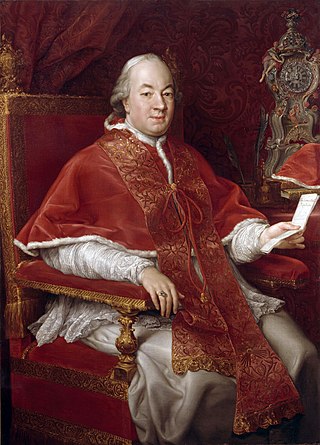
Pope Pius VI was head of the Catholic Church and ruler of the Papal States from 15 February 1775 to his death in August 1799.

Pope Leo XII, born Annibale Francesco Clemente Melchiorre Girolamo Nicola della Genga, was head of the Catholic Church and ruler of the Papal States from 28 September 1823 to his death in February 1829.

Pope Pius VII was head of the Catholic Church from 14 March 1800 to his death in August 1823. He ruled the Papal States from June 1800 to 17 May 1809 and again from 1814 to his death. Chiaramonti was also a monk of the Order of Saint Benedict in addition to being a well-known theologian and bishop.

The Concordat of 1801 was an agreement between Napoleon Bonaparte and Pope Pius VII, signed on 15 July 1801 in Paris. It remained in effect until 1905, except in Alsace–Lorraine, where it remains in force. It sought national reconciliation between revolutionaries and Catholics and solidified the Roman Catholic Church as the majority church of France, with most of its civil status restored. This resolved the hostility of devout French Catholics against the revolutionary state. It did not restore the vast Church lands and endowments that had been seized during the Revolution and sold off. Catholic clergy returned from exile, or from hiding, and resumed their traditional positions in their traditional churches. Very few parishes continued to employ the priests who had accepted the Civil Constitution of the Clergy of the revolutionary regime. While the Concordat restored much power to the papacy, the balance of church-state relations tilted firmly in Napoleon's favour. He selected the bishops and supervised church finances.

A papal coronation is the formal ceremony of the placing of the papal tiara on a newly elected pope. The first recorded papal coronation was of Pope Nicholas I in 858. The most recent was the 1963 coronation of Paul VI, who soon afterwards abandoned the practice of wearing the tiara. To date, none of his successors have used the tiara, and their papal inauguration celebrations have included no coronation ceremony, although any future pope may elect to restore the use of the tiara at any point during his pontificate.

Joseph Cardinal Fesch, Prince of the Empire was a French priest and diplomat, who was the maternal half-uncle of Napoleon Bonaparte. In the wake of his nephew, he became Archbishop of Lyon and cardinal. He was also one of the most famous art collectors of his period, remembered for having established the Musée Fesch in Ajaccio, which remains one of the most important Napoleonic collections of art.

Jean-Sifrein Maury was a French cardinal, archbishop of Paris, and former bishop of Montefiascone.
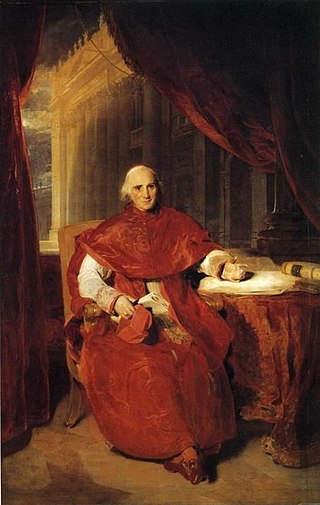
Ercole Consalvi was a deacon and cardinal of the Catholic Church, who served twice as Cardinal Secretary of State for the Papal States and who played a crucial role in the post-Napoleonic reassertion of the legitimist principle of the divine right of kings, of which he was a constant supporter.

The papal conclave that followed the death of Pius VI on 29 August 1799 lasted from 30 November 1799 to 14 March 1800 and led to the selection of Cardinal Barnaba Chiaramonti, who took the name Pius VII. This conclave was held in Venice and was the last to take place outside Rome. This period was marked by uncertainty for the papacy and the Roman Catholic Church following the invasion of the Papal States and abduction of Pius VI under the French Directory.

The papal conclave held from 2 to 28 September 1823 ended with the election of Annibale della Genga to succeed the death recently deceased Pius VII as pope. Della Genga took the name Leo XII.
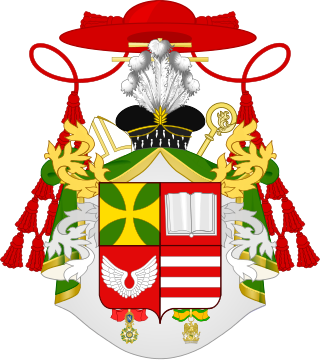
Giovanni Battista Caprara Montecuccoli was an Italian statesman and cardinal and archbishop of Milan from 1802 to 1810. As a papal diplomat he served in the embassies in Cologne, Lausanne, and Vienna. As Legate of Pius VII in France, he implemented the Concordat of 1801, and negotiated with the Emperor Napoleon over the matter of appointments to the restored hierarchy in France. He crowned Napoleon as King of Italy in Milan in 1805.

According to Roman Catholicism, the history of the papacy, the office held by the pope as head of the Catholic Church, spans from the time of Peter to the present day.

The Napoleon Tiara was a papal tiara given to Pope Pius VII in June 1805 a few months after he presided at the coronation of Napoleon I and Joséphine de Beauharnais. While lavishly decorated with jewels, it was deliberately too small and heavy to be worn and meant as an insult to the Pope. In the painting of The Coronation of Napoleon by Jacques-Louis David, the tiara is held behind the Pope by one of his aides.

Giulio Gabrielli was an Italian cardinal in the Catholic Church. He spent most of his career in the Roman Curia.
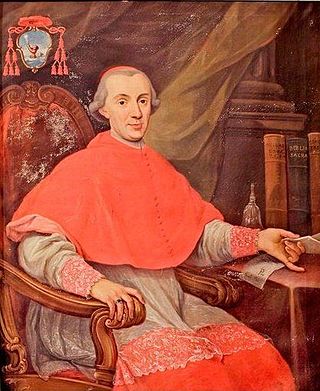
Leonardo Antonelli was an Italian Cardinal in the Roman Catholic Church.

Bartolomeo Pacca was an Italian cardinal, scholar, and statesman as Cardinal Secretary of State. Pacca served as apostolic nuncio to Cologne, and later to Lisbon.
The modern history of the papacy is shaped by the two largest dispossessions of papal property in its history, stemming from the French Revolution and its spread to Europe, including Italy.

Giuseppe Maria Doria Pamphili was an Italian cardinal of the Catholic Church who served as Cardinal Secretary of State.
Quum memoranda was a papal brief issued by Pope Pius VII in 1809. It was a response to a decree issued by Emperor Napoleon, on 17 May 1809, which incorporated the remnants of the Papal States into the French Empire, during the Napoleonic Wars. The brief was published on 10 June, the day of the decree's proclamation in Rome, capital of the Papal States, with an excommunication of Napoleon and all those who had contributed to what the Holy See saw as a violation of its temporal power.

Francesco Bertazzoli was an Italian prelate of the Catholic Church who was a longtime confidant of Pope Pius VII, who made him a cardinal in 1823.